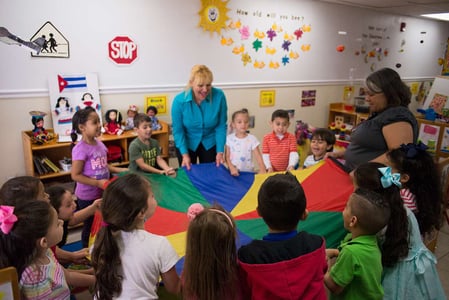
One of my biggest takeaways from the childcare calculator we talked about recently was how much it would cost to increase early childhood educators’ wages. It wasn’t shocking—if you’re looking to get some laughs, ask any teacher you know if they’re in education to make big money—but it was a disappointing reminder of just how little we pay those who are shaping our future. The recently-released 2018 Early Childhood Workforce Index gives us some specifics around compensation in early childhood education and care.
Nationally, the median wage for child care workers is $10.72 per hour, putting them in the 2nd percentile for wages. That means that 98% of workers make more money than the average infant or toddler teacher. It should be unsurprising, then, that over half of the families of child care workers (53%) were enrolled in public support or health care programs.
Pre-K teachers, regardless of care setting, are compensated slightly better, with a median wage of $13.94. The pay nearly doubles for preschool teachers in school-based settings, to $26.88, but even that is noticeably less than the median salaries for kindergarten ($31.29) and other elementary teachers ($32.98). And while the median American wage has increased slightly since 2015, this positive trend hasn’t been seen for preschool teachers (or their center directors). In fact, adjusted for inflation, preschool teachers are making about 1.4% less than they were in 2015.
The differences in pay aren’t just divided by setting—they’re related to the age of the children being cared for. Despite the fact that research is demonstrating the importance of birth-to-three learning, teachers working with younger children are systematically paid approximately $2 per hour less than those working with pre-K kids. One might hypothesize that this wage penalty for infant and toddler teachers has to do with educational requirements, which tend to be more regulated for teachers of older children. While teachers with higher educational attainment do make more, the age-wage gap exists at every level of education. In fact, a teacher with a Bachelor’s or graduate degree working with infants or toddlers could expect to make over $4 per hour less than if they’d instead chosen to work with three- to five-year-olds.
As with most issues in the labor market, race and gender also play a role in compensation for early childhood educators. Even accounting for educational attainment, white teachers earn more than educators of color. The report estimates that, on average, African Americans are paid $1,622.40 less per year than their white counterparts.
Whew...I’m emotionally exhausted just reading that. Effective early educators are crucial for children’s learning and development, but it’s hard to justify the effort of education and professional development for the low compensation. After all, who wants to borrow tens of thousands of dollars to pay for a Bachelor’s in early childhood education—the degree path with the lowest lifetime earning potential?
So what can be done to support young children and the adults who care for them? The authors of the report offer a few suggestions. One is for states to systematically increase wages. As they put it, “articulate compensation standards, make them mandatory, and provide both system reform and sufficient public funding to meet those standards.” Another is to create and foster pathways that allow teachers to become more highly qualified and to support them with scholarships, sponsorships, and educational assistance. States, localities, and programs can also craft policies that improve work environments, such as increased staffing or paid leave policies.
Over the last several years, we’ve seen progress in the early childhood field. Much of this comes on the shoulders of early childhood educators, who have been asked to do increasingly more to support children’s learning. Now, the science is catching up with policy. States are increasing funding for and enrollment in ECE. The 2018 federal budget provided an additional $5.8 billion for the Child Care and Development Block Grant (CCDBG), and Head Start also received a funding increase. With this financial investment comes the potential to better support the resource we have in every single classroom: educators.
Citation: Whitebook, M., McLean, C., Austin, L.J.E., & Edwards, B. (2018). Early Childhood Workforce Index - 2018. Berkeley, CA: Center for the Study of child Care Employment, University of California, Berkeley. Retrieved from http://cscce.berkeley.edu/early-childhood-workforce-2018-index/

